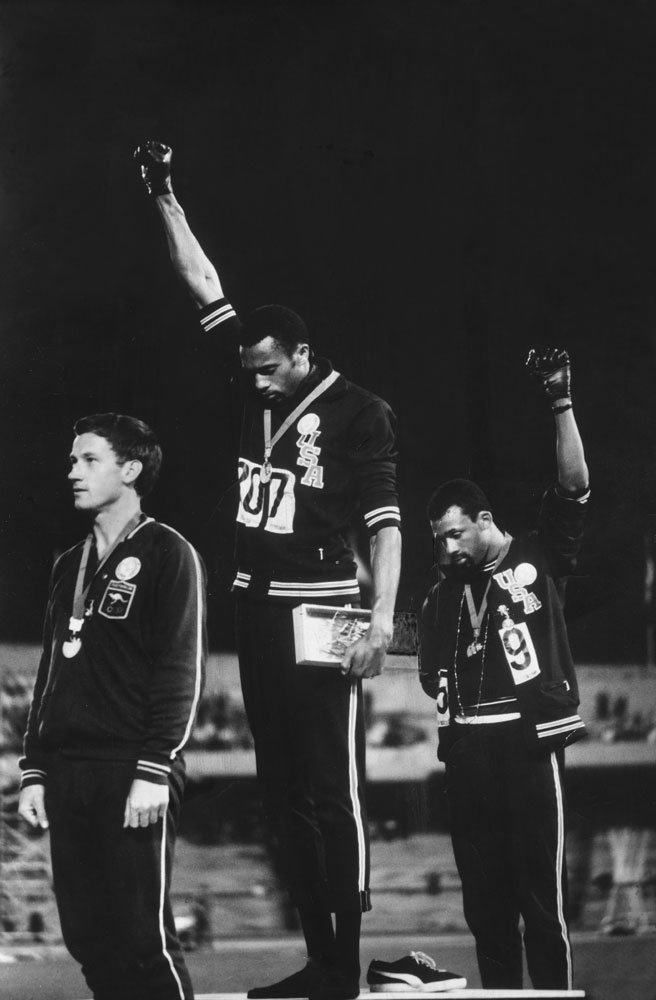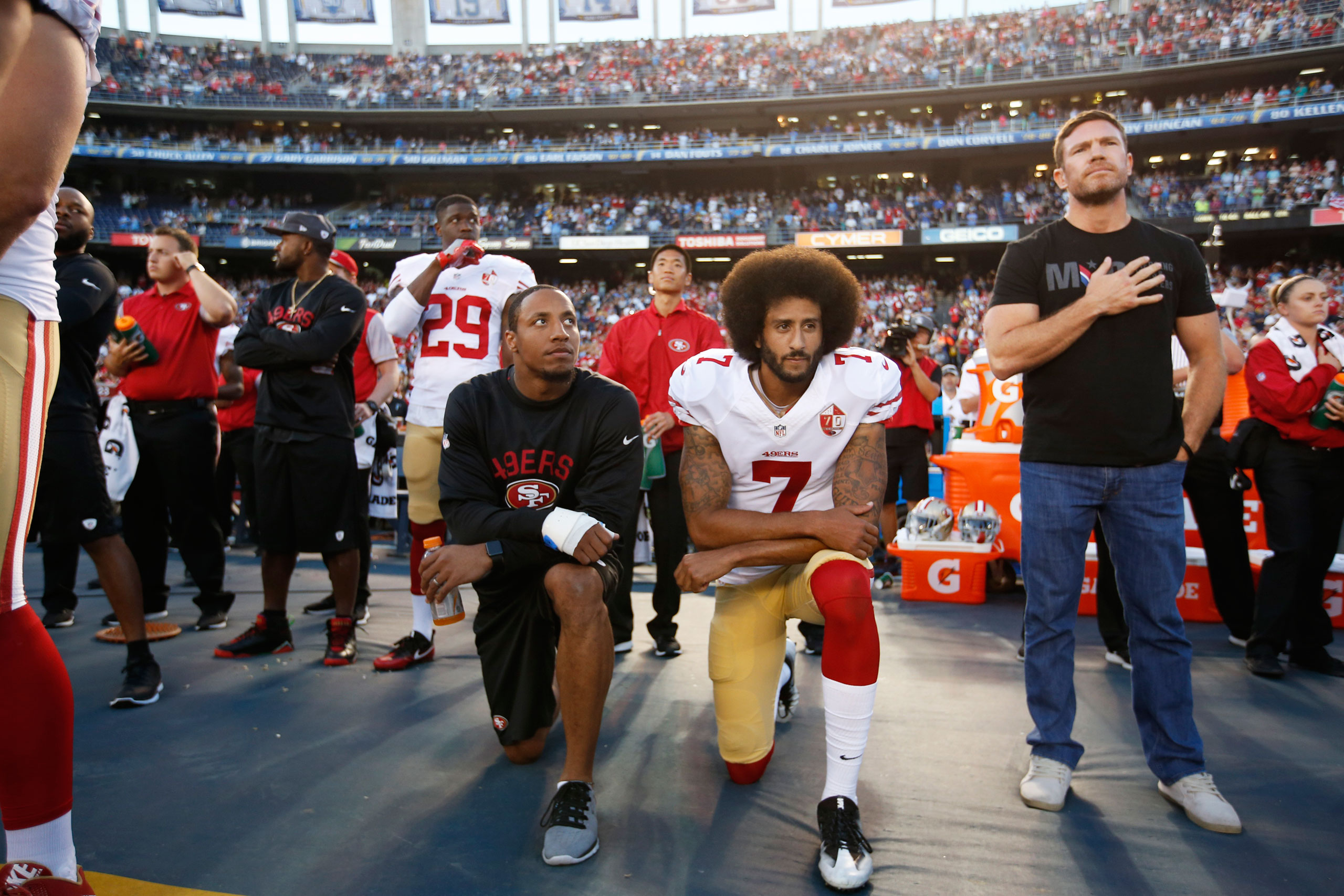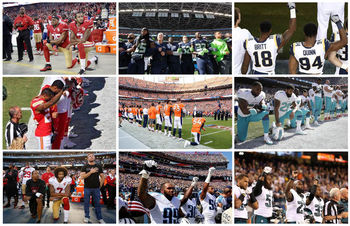For centuries, sports have not merely been seen as a way to exercise or be entertained. Sports have been tied to politics and have become a platform for peaceful protests. Sports draws people together. In the last few decades it has become a gigantic business but throughout history, sports have also led to propaganda and boycotts.
As an athlete, I have always been fascinated by the power of sport: the power it has to change lives and influence those watching. Within the context of global protests, sports protests have mainly occurred in the United States. Here are five examples of American sports protests linked to labor movements.

“The Human Rights Salute”
On October 16, 1968, at the Olympic Games in Mexico, Tommie Smith and John Carlos, two African American sprinters, won the gold and bronze medals for the 200 meter track and field event. As they stood on the podium and the American anthem was played, the two athletes lowered their heads and lifted their fists in the air, protesting racial segregation in the United States. Smith and Carlos were then accused of trying to introduce politics within the stadium. Both received their medals shoeless to emphasize black poverty. Both had planned to wear a pair of black gloves, but since Carlos forgot his, Smith gave Carlos his left glove. Smith wore a black scarf to represent black pride, while Carlos, in solidarity with blue-collar workers in the United States wore his tracksuit unzipped, as well as a bead necklace.
“The beads were for those individuals that were lynched, or killed that no-one said a prayer for, that were hung and tarred. It was for those thrown off the side of the boats in the middle passage”. After Smith and Carlos were evicted from Mexico, three of their teammates: Larry James, Lee Evans and Ron Freeman won gold, silver and bronze in the 400 meter event. They protested in their own way by walking onto the podium with black berets on their heads and fists in the air, but took them off as soon as the national anthem started to play. Black American athletes were divided after this political protest that highlighted the 1968 Olympic Games. In the end, The Human Rights Salute only got Smith and Carlos kicked off the team in 1968. Today, it is considered one of the most powerful and famous peaceful protests in sports. The 1968 Olympics are associated with The Human Rights Salute. The athletes may not have had the response they were hoping for from the IOC, but all Americans knew what happened and the protest made the front page of newspapers.
The Miami Heat Hoodies
On March 23, 2012, Lebron James, NBA Miami Heat player posted a picture of his team wearing hooded sweatshirts to support Trayvon Martin’s family after the teenager was killed wearing a hoodie. On March 21, 2012, a demonstration also known as “the Million Hoodie March” was held in New York City to put an end to racial profiling. Lebron James’ post included the following hashtags, following a broader campaign against racial injustices and unequal treatment of people of color in the U.S.. #WeAreTrayvonMartin #Hoodies #Stereotyped #WeWantJustice. Though the Miami Heat did not have an impact on the impact of the Trayvon Martin trial which occurred a year later, they rose awareness and spread hashtags to mobilize people to speak up about discrimination and unjustified violence against people of color, particularly Black Americans. Though a one-time campaign, the picture circulated on social media and attracted much attention.
“I Can’t Breathe”
On December 8, 2014, MBA Cleveland Cavaliers forward LeBron James and guard Kyrie Irving and the Brooklyn Nets' Kevin Garnett, Deron Williams, Jarrett Jack and Alan Anderson all wore "I Can't Breathe" t-shirts before their game in support and remembrance of African American Eric Garner, who on July 7th , 2014 died at age 43 in Staten Island, NY, after being heard in a video saying “I can’t breathe” as he was brought to the ground in a chokehold by an NYPD officer. According to MVPIndex, between December 1st and December 11, 2014, nearly 50 instances of NFL players posted and retweeted nearly 50 times the "I Can't Breathe" phrase across social media. This did not have any effect on the professional athletes careers; instead it brought attention to the racial injustices and sports protests themselves. The Lakers also joined the “I can’t breathe” sport protest wearing the same white print on black T-shirts on December 9, 2014, as a way to stand up for their rights. The players were not able to wear the T-shirts during the game, in which they were required to wear their jerseys, but tensions regarding the case within the team did not emerge. The demography of this protest was mostly constituted of African Americans who used social media and organized mass peaceful gatherings. Overall, I wonder how many protestors undertook in the peaceful marches, the “I can’t breathe” campaign thanks to the athletes.

Kolin Kaepernick – more than kneeling, an activist
In November 2016, two dozen football players for the National Football League (NFL) knelt on the field during the national anthem to silently protest racial inequality. They were strongly criticized by President Trump who shared an inflamed declaration, stating, “Wouldn’t you love to see one of these NFL owners, when somebody disrespects our flag, to say, ‘Get that son of a bitch off the field right now. Out! He’s fired. He’s fired!’’’. The players’ protest mainly took place during the week of Thanksgiving 2016 but continued throughout the football season. While some players kneeled during the anthem, others raised a fist, and one stayed off the field. On April 21, 2018, Kaepernick was honored by Amnesty International who gave him the ambassador of conscience award for kneeling at games to protest racial inequality. Kaepernick’s activism is not new. As a college football player, he was known to have spoken up against excessive use of force in America against Blacks and defend his personal rights. A major factor in the NFL protest led by Kaepernick was the question of race. In a Duke University event for Martin Luther King Jr. Day, Professor of African and African American Studies and the founding director of the Center for Arts, Digital Culture and Entrepreneurship (CADCE), Professor Mark Anthony Neal stated that “[a white player] who is mediocre and protests is more accepted than an excellent player of color”. He then added “athletes are really good figures to speak up and protest. One should be able to give their opinion no matter what age or race they are”. Kaepernick’s knee inspired more athletes such as American soccer player Megan Rapinoe who was the first and last white American soccer player to take a knee before the U.S. Soccer Federation passed policy 604-1 forbidding players to kneel during the national anthem: “All persons representing a Federation national team shall stand respectfully during the playing of national anthems at any event in which the Federation is represented”. Kaepernick often shares quotes and his thoughts on his twitter page, which often stays free of hashtags, but isn’t spared from tags of him and his activism. While the kneeling infuriated President Donald Trump, who considered the gesture a "total disrespect" to the United States, Kaepernick was successful in establishing a national commitment across many football teams. Kaepernick’s gesture created much debate and division across America, as White and Black players showed their support, but white male NFL team owners showed their discontent and disagreement with the kneeling, mostly because they support President Donald Trump and believe the controversial protests would make them lose money. Kaepernick did not respond to Trump directly, instead continuing his engagement, sharing political messages on his social media and continuing his gestures at games. He faced challenges from his team owner, himself pressured by Trump to find a rule to oblige the players to stop kneeling during the national anthem.
"The Human Rights Salute"
The athletes were protesting for civil rights and equal rights for all Americans: white and black.

"I Can't Breathe"
The basketball players protested against racial injustices, after the white police officer was not indicted for killing unarmed Eric Garner.
Throughout various sports protests, athletes have mostly fought for civil rights equality, protesting unequal treatment based on race or gender within the United States.
Like the University of Missouri 2015 football protest, these four protests all have the same aspirations: to improve the rights and conditions of working people, stand up for their rights and question justice systems and those in power who may be abusing their authority.
Sports protests raise awareness and invite spectators and fans to become engaged and speak up. Most sports protests are organized to defend equal rights for all, especially people of color who have been unequally treated for centuries in the United States. The athletes' point is to get people engaged and aware of certain issues, be it race, religion, gender, social class or previous activism or engagement.
Most sports protests occur during professional athletes’ careers at games broadcasted on the national television. Their tactics differ but current protests are often heavily linked to social media using hashtags and pictures. Thanks to the athletes’ fame, the protests are then covered by newspapers, magazines, and fans who link the information to the wider public and share the information with their own followers and readers.
"The Human Rights Salute"
Two days after receiving their medals, Smith and Carlos were required by the American Olympic Committee to leave the Olympic village and Mexico. The president of the IOC at the time, Avery Brundage, was furious. He may even have felt personally targeted during the protest and did not wish the Olympic Games to have political propaganda, 32 years after the 1936 Olympic Games in Germany, when Adolf Hitler was in power.
"I Can't Breathe"
While certain fans supported these online posts, others defended the police declaring they were doing their jobs. The goal of the athletes and other protestors was to raise awareness and denounce the injustices Black Americans face.
The four protests reflect the challenges of sports protests, which are almost never continuous and are not organized by a particular group. Oppositional forces often include people in positions of power such as team owners, politicians or racist spectators.

